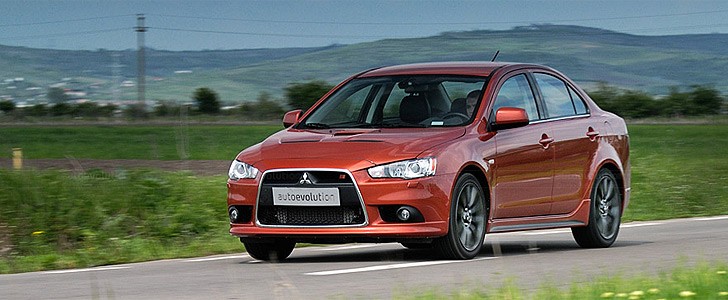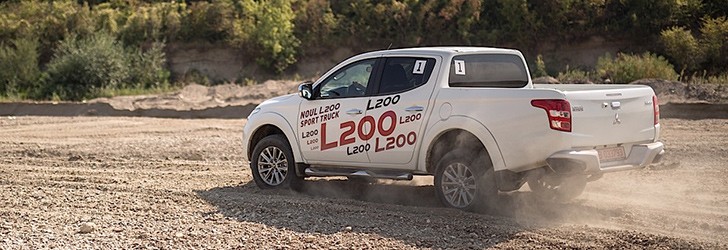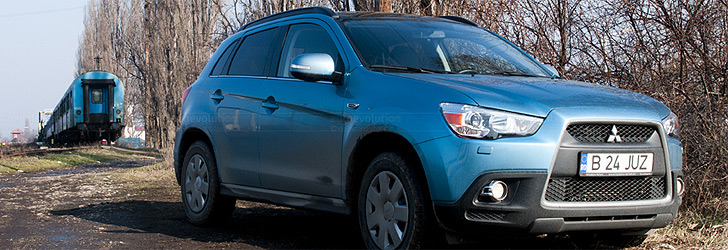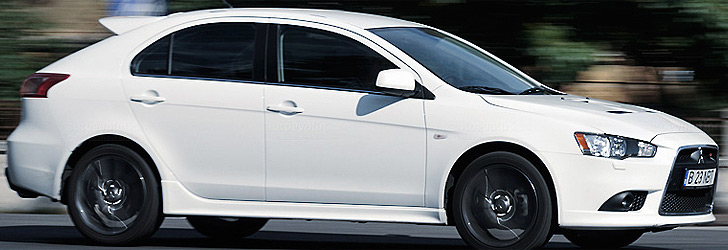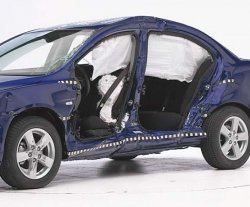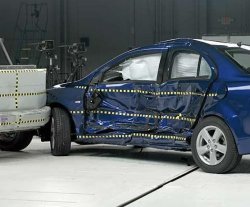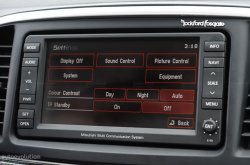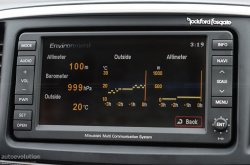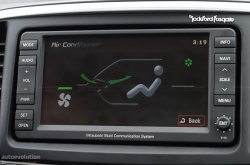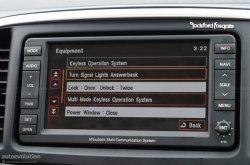MITSUBISHI Lancer Ralliart Review
OUR TEST CAR: MITSUBISHI Lancer Ralliart test drive, review, road test
Mitsubishi Lancer is by no means a regular car and the history hidden underneath the Lancer designation is just the living proof. The first time the automotive world heard about the Lancer was in January 1973 when the Japanese company rolled off the assembly lines a total of twelve versions, equipped with engines ranging from 1.2- to 1.6-liters. Ever since that moment, Mitsubishi's Lancer managed to make a name for itself in almost every single sector it stepped in.
The Ralliart nameplate however joined forces with Lancer's engineers only for the eighth generation, in 2004, with the de-tuned version created to serve as the second most powerful Lancer in the whole range.
The current Ralliart was revealed to the public in 2008 at the North American International Auto Show, while sales in the United States started in October the same year. It arrived in Europe a few months later and now competes against Subaru Impreza WRX and Volkswagen Golf R20.
Unfortunately for all models carrying the Ralliart badge, Mitsubishi's motosport and high-performance division closed its doors in April, citing the same difficult economic recession that pushed giants General Motors and Chrysler under Chapter 11 protection as the main reason. However, we've learned that Mitsubishi might take the whole division under its very own umbrella, which is the first sign that Ralliart could live on anyway.
The Ralliart flavor of Mitsubishi Lancer or, if you prefer, Chrysler Lancer, Eagle Summit, Hindustan Lancer, Soueast Lioncel, Mitsubishi Carisma or Mitsubishi Mirage (the model used various names depending on the location and the company that handled production) is actually a de-tuned version of Evolution X addressed to people who'd like a sporty car at a more affordable price.
Obviously, Evolution X served as source of inspiration for the Ralliart version, so some of the design and technical elements can be seen on this cheaper variant too. The car was especially created to fill the gap between the base Lancer and the amazing Evolution X, so most of its features are somewhere in between the ones provided by these two models.
We took the Lancer Ralliart for a testdrive, so keep reading to find our findings on the 2.0-liter MIVEC turbocharged intercooled engine, the 6-speed Twin-Clutch Sportronic Shift Transmission (TC-SST) or the full-time all-wheel drive system.
The exterior of the Lancer seems to perfectly suit the sports car definition. It's true that it borrows some design elements from the Evo X, but there's nothing wrong about it, after all it offers all these high-performance features at a more affordable price.
The bonnet, together with the air vents are coming directly from the Evo X and not only that they help cool the engine, but they also enhance the car's sporty and aggressive attitude.
From this point of view, the front fascia is indeed a masterpiece. The black upper and lower "Jet Fighter" grille with large chrome surround is accompanied by round fog lights and adaptive Bi-Xenon headlights. Moving our eyes towards the side of the car, we meet body-colored door handles, 18-inch alloy wheels with Yokohama ADVAN A10 215/45R18 summer performance tires and chromed door molding. At the rear, we get the dual chrome exhaust tips and the clear and black taillights.
Fortunately, the tested car wasn't equipped with the standard color-keyed rear spoiler, as this styling element is often considered a negative design aspect. Instead, the car was equipped with a smaller and more appropriate spoiler that perfectly fits the rear design and doesn't affect the sporty feeling at all.
The car measures 180 inches (4,570 mm) x 69.3 inches (1,760 mm) x 58.7 inches (1,490 mm) and has a wheelbase of 103.7 inches (2,635 mm), quite decent for a high performance car that was initially supposed to serve as a family model.
However, the family cues are still visible on the technical specifications list, as the car offers 283 liters of luggage volume (257 liters with a subwoofer mounted inside the trunk such as the one on our model).
What we found quite uncanny is the rounded tailgate lid button that's placed just near the Lancer designation and is surrounded by an aluminum trim. A more special door opening system, with the tree-diamond Mitsubishi logo acting as a button, would be more appropriate to maintain the overall design of the rear untouched.
The exterior sportiness goes inside the Lancer Ralliart and it receives a polite welcome from the leather-wrapped sport front bucket seats. And speaking of seats, the car features a 6-way adjustable driver's seat, with large bolster that kindly "hug" you when pressing the throttle pedal. The tilt-adjustable steering wheel provides instant access to some of the most important functions of the car, including the audio system and cruise control, through the left-side and right-side mounted buttons, respectively.
Furthermore, the steering wheel holds the two shift paddles which could give you a bit of WRC feeling if you wish to deactivate the twin-clutch transmission. Last but not least, the leather-wrapped steering wheel allows you to control the Bluetooth system, so you can easily talk on your phone while keeping the eyes on the road.
Basically, all things are exactly where you'd expect them to be. The power window controls are placed on the driver's doors, alongside the exterior mirror controls and the door locking button.
The center console however comes with a very simple yet elegant design. Basically, because the only controls you'll see there are the ones concerning the automatic climate control, the rest of the car's functions can be easily accessed through an LCD screen with touch support. In just a few words (we'll detail the display's functions in the gadgets section), this device controls both the navigation and the audio system, while also providing vital information such as fuel consumption and emissions level.
The interior seems to be comfy enough for both the front and the rear passengers, but the test with our 2-meter tall colleague proved otherwise. Traveling as a rear passenger doesn't seem too much of a problem, while getting behind the wheel might cause some headaches, mostly to taller persons. It's almost impossible to drive a Lancer Ralliart if you're measuring more than 2 meters (6 ft 6 in) in height, regardless of the seat and steering wheel position.
With such great power under the hood, it's a shame to drive this car in an urban environment. Mostly because you cannot enjoy the acceleration and performance times the 2.0-liter engine has to offer. But still, Lancer could be somewhat suitable for city cruising.
According to Mitsubishi's very own figures, Ralliart's powertrain configuration should achieve 17 mpg (13.8 l/100km) on city roads, but the best we could get was 15 mpg (approximately 15.6 l/100km) after a 15 km trip during a morning rush hour.
Just like in any other crowded city, the dual-clutch transmission does its job perfectly, allowing the driver to relax his left foot while being stuck in traffic jams, without the need to shift gears.
Comfort isn't a problem at all, as the suspension system, although configured to suit a sporty driving style, helps you pass over speed bumps without even noticing them. Things are a bit different when driving on uneven roads, but there's nothing wrong with that since we're dealing with such a high performance car.
Our car boasted a trunk volume of 257 liters (reduced to this size due to the subwoofer), which means it should be large enough to hold all the shopping bags. There are no cargo nets whatsoever, so you should really be careful with your luggage once you put them inside the Lancer.
Parking a car with these dimensions shouldn't be too difficult, but taking into account today's traffic and the number of cars (as compared to the available parking spots), every single system design to assist you during the parking maneuver is welcome. Unfortunately, our Lancer Ralliart came with no such technologies, not even parking sensors, but we really didn't experience harsh times squeezing into an empty spot.
Visibility level is below average, with both the windshield and the rear window providing a decent view on the road. Furthermore, the two exterior mirrors are large enough to keep you up to date with what happens behind the car, but blind spots are not eliminated at all.
And this is where the whole fun begins. With a 2.0-liter engine able to generate 240 horsepower and a Twin Clutch-SST gearbox, Mitsubishi Lancer Ralliart seems to be a great companion when leaving the city.
First of all, fuel consumption. If we are to trust Mitsubishi's estimated figures, the Lancer Ralliart should go around 30 mpg (approximately 7.8 l/100km). However, after around 20 kilometers outside the city and the most efficient driving we could achieve, the on-board computer was indicating 21 mpg (11. 2 l/100km).
Obviously, such a fuel consumption isn't so bad as most car enthusiasts out there would be tempted to believe, especially if we're taking into account the impressive power that "sits" under the hood.
The SST transmission is once again a plus, contributing to the overall comfort of the ride which, combined with cruise control, goes above the average you'll find on today's cars. And speaking of comfort, a passenger with an average height would have no problem stepping inside a Lancer Ralliart either as driver or as passenger.
Going over two meters in height however represents a problem (no offense to our mate, we're just speaking about the Lancer). In this case, driving the car is impossible because the knees are stuck underneath the steering wheel so pressing the brake pedal is just difficult.
Still, the engine feels great at high speeds. Although it has been often criticized for lag (as compared to other advanced automatic units or to Volkswagen's DSG), the SST configuration seems to do its job in a decent and remarkable way. Overtaking slower drivers is just a simple activity, as the power calmly waits for you to press the throttle pedal. There are two modes available, Normal and Sport, with the second providing the perfect torque for the car to achieve its maximum performance level.
One of the goodies the guys over at Mitsubishi have prepared is the full-time 4WD system with Active Center Differential (ACD). This means the Ralliart flavor of the Lancer can easily step beyond the "regular" road car category and jump into the performance-oriented model to make adrenaline rush through its driver's veins.
In just a few words (you'll find all the techy stuff detailed in the Tech Facts section), there are three available modes that allow the car to adjust its settings depending on the road conditions. The driver just has to select between Tarmac, Gravel, or Snow surfaces and the car automatically adjusts its figures for the optimal balance between steering and traction.
The Ralliart nameplate however joined forces with Lancer's engineers only for the eighth generation, in 2004, with the de-tuned version created to serve as the second most powerful Lancer in the whole range.
The current Ralliart was revealed to the public in 2008 at the North American International Auto Show, while sales in the United States started in October the same year. It arrived in Europe a few months later and now competes against Subaru Impreza WRX and Volkswagen Golf R20.
Unfortunately for all models carrying the Ralliart badge, Mitsubishi's motosport and high-performance division closed its doors in April, citing the same difficult economic recession that pushed giants General Motors and Chrysler under Chapter 11 protection as the main reason. However, we've learned that Mitsubishi might take the whole division under its very own umbrella, which is the first sign that Ralliart could live on anyway.
The Ralliart flavor of Mitsubishi Lancer or, if you prefer, Chrysler Lancer, Eagle Summit, Hindustan Lancer, Soueast Lioncel, Mitsubishi Carisma or Mitsubishi Mirage (the model used various names depending on the location and the company that handled production) is actually a de-tuned version of Evolution X addressed to people who'd like a sporty car at a more affordable price.
Obviously, Evolution X served as source of inspiration for the Ralliart version, so some of the design and technical elements can be seen on this cheaper variant too. The car was especially created to fill the gap between the base Lancer and the amazing Evolution X, so most of its features are somewhere in between the ones provided by these two models.
We took the Lancer Ralliart for a testdrive, so keep reading to find our findings on the 2.0-liter MIVEC turbocharged intercooled engine, the 6-speed Twin-Clutch Sportronic Shift Transmission (TC-SST) or the full-time all-wheel drive system.
The exterior of the Lancer seems to perfectly suit the sports car definition. It's true that it borrows some design elements from the Evo X, but there's nothing wrong about it, after all it offers all these high-performance features at a more affordable price.
The bonnet, together with the air vents are coming directly from the Evo X and not only that they help cool the engine, but they also enhance the car's sporty and aggressive attitude.
From this point of view, the front fascia is indeed a masterpiece. The black upper and lower "Jet Fighter" grille with large chrome surround is accompanied by round fog lights and adaptive Bi-Xenon headlights. Moving our eyes towards the side of the car, we meet body-colored door handles, 18-inch alloy wheels with Yokohama ADVAN A10 215/45R18 summer performance tires and chromed door molding. At the rear, we get the dual chrome exhaust tips and the clear and black taillights.
Fortunately, the tested car wasn't equipped with the standard color-keyed rear spoiler, as this styling element is often considered a negative design aspect. Instead, the car was equipped with a smaller and more appropriate spoiler that perfectly fits the rear design and doesn't affect the sporty feeling at all.
The car measures 180 inches (4,570 mm) x 69.3 inches (1,760 mm) x 58.7 inches (1,490 mm) and has a wheelbase of 103.7 inches (2,635 mm), quite decent for a high performance car that was initially supposed to serve as a family model.
However, the family cues are still visible on the technical specifications list, as the car offers 283 liters of luggage volume (257 liters with a subwoofer mounted inside the trunk such as the one on our model).
What we found quite uncanny is the rounded tailgate lid button that's placed just near the Lancer designation and is surrounded by an aluminum trim. A more special door opening system, with the tree-diamond Mitsubishi logo acting as a button, would be more appropriate to maintain the overall design of the rear untouched.
The exterior sportiness goes inside the Lancer Ralliart and it receives a polite welcome from the leather-wrapped sport front bucket seats. And speaking of seats, the car features a 6-way adjustable driver's seat, with large bolster that kindly "hug" you when pressing the throttle pedal. The tilt-adjustable steering wheel provides instant access to some of the most important functions of the car, including the audio system and cruise control, through the left-side and right-side mounted buttons, respectively.
Furthermore, the steering wheel holds the two shift paddles which could give you a bit of WRC feeling if you wish to deactivate the twin-clutch transmission. Last but not least, the leather-wrapped steering wheel allows you to control the Bluetooth system, so you can easily talk on your phone while keeping the eyes on the road.
Basically, all things are exactly where you'd expect them to be. The power window controls are placed on the driver's doors, alongside the exterior mirror controls and the door locking button.
The center console however comes with a very simple yet elegant design. Basically, because the only controls you'll see there are the ones concerning the automatic climate control, the rest of the car's functions can be easily accessed through an LCD screen with touch support. In just a few words (we'll detail the display's functions in the gadgets section), this device controls both the navigation and the audio system, while also providing vital information such as fuel consumption and emissions level.
The interior seems to be comfy enough for both the front and the rear passengers, but the test with our 2-meter tall colleague proved otherwise. Traveling as a rear passenger doesn't seem too much of a problem, while getting behind the wheel might cause some headaches, mostly to taller persons. It's almost impossible to drive a Lancer Ralliart if you're measuring more than 2 meters (6 ft 6 in) in height, regardless of the seat and steering wheel position.
With such great power under the hood, it's a shame to drive this car in an urban environment. Mostly because you cannot enjoy the acceleration and performance times the 2.0-liter engine has to offer. But still, Lancer could be somewhat suitable for city cruising.
According to Mitsubishi's very own figures, Ralliart's powertrain configuration should achieve 17 mpg (13.8 l/100km) on city roads, but the best we could get was 15 mpg (approximately 15.6 l/100km) after a 15 km trip during a morning rush hour.
Just like in any other crowded city, the dual-clutch transmission does its job perfectly, allowing the driver to relax his left foot while being stuck in traffic jams, without the need to shift gears.
Comfort isn't a problem at all, as the suspension system, although configured to suit a sporty driving style, helps you pass over speed bumps without even noticing them. Things are a bit different when driving on uneven roads, but there's nothing wrong with that since we're dealing with such a high performance car.
Our car boasted a trunk volume of 257 liters (reduced to this size due to the subwoofer), which means it should be large enough to hold all the shopping bags. There are no cargo nets whatsoever, so you should really be careful with your luggage once you put them inside the Lancer.
Parking a car with these dimensions shouldn't be too difficult, but taking into account today's traffic and the number of cars (as compared to the available parking spots), every single system design to assist you during the parking maneuver is welcome. Unfortunately, our Lancer Ralliart came with no such technologies, not even parking sensors, but we really didn't experience harsh times squeezing into an empty spot.
Visibility level is below average, with both the windshield and the rear window providing a decent view on the road. Furthermore, the two exterior mirrors are large enough to keep you up to date with what happens behind the car, but blind spots are not eliminated at all.
And this is where the whole fun begins. With a 2.0-liter engine able to generate 240 horsepower and a Twin Clutch-SST gearbox, Mitsubishi Lancer Ralliart seems to be a great companion when leaving the city.
First of all, fuel consumption. If we are to trust Mitsubishi's estimated figures, the Lancer Ralliart should go around 30 mpg (approximately 7.8 l/100km). However, after around 20 kilometers outside the city and the most efficient driving we could achieve, the on-board computer was indicating 21 mpg (11. 2 l/100km).
Obviously, such a fuel consumption isn't so bad as most car enthusiasts out there would be tempted to believe, especially if we're taking into account the impressive power that "sits" under the hood.
The SST transmission is once again a plus, contributing to the overall comfort of the ride which, combined with cruise control, goes above the average you'll find on today's cars. And speaking of comfort, a passenger with an average height would have no problem stepping inside a Lancer Ralliart either as driver or as passenger.
Going over two meters in height however represents a problem (no offense to our mate, we're just speaking about the Lancer). In this case, driving the car is impossible because the knees are stuck underneath the steering wheel so pressing the brake pedal is just difficult.
Still, the engine feels great at high speeds. Although it has been often criticized for lag (as compared to other advanced automatic units or to Volkswagen's DSG), the SST configuration seems to do its job in a decent and remarkable way. Overtaking slower drivers is just a simple activity, as the power calmly waits for you to press the throttle pedal. There are two modes available, Normal and Sport, with the second providing the perfect torque for the car to achieve its maximum performance level.
One of the goodies the guys over at Mitsubishi have prepared is the full-time 4WD system with Active Center Differential (ACD). This means the Ralliart flavor of the Lancer can easily step beyond the "regular" road car category and jump into the performance-oriented model to make adrenaline rush through its driver's veins.
In just a few words (you'll find all the techy stuff detailed in the Tech Facts section), there are three available modes that allow the car to adjust its settings depending on the road conditions. The driver just has to select between Tarmac, Gravel, or Snow surfaces and the car automatically adjusts its figures for the optimal balance between steering and traction.
12
Our MITSUBISHI Testdrives:
Photo gallery (111)
